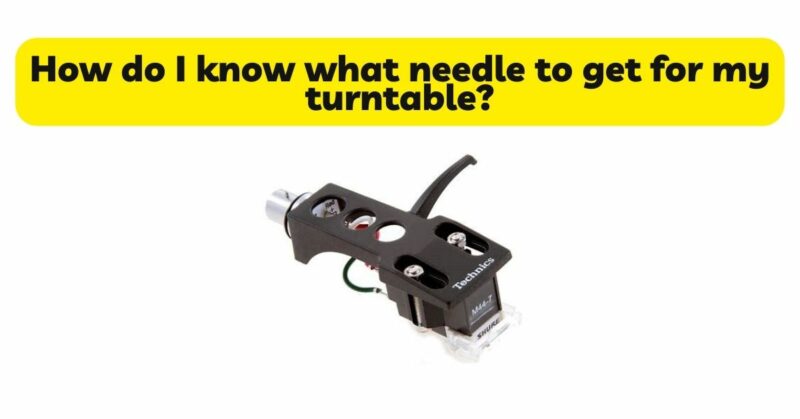Selecting the right needle, or stylus, for your turntable is crucial to ensure optimal sound quality and compatibility. With the wide range of options available, it can be challenging to determine which needle is best suited for your specific turntable model. In this article, we will guide you through the process of choosing the correct needle, providing valuable insights and practical tips to help you make an informed decision.
- Consult the Manufacturer: The first step in selecting a needle for your turntable is to consult the manufacturer’s documentation or website. Turntable manufacturers often provide detailed information regarding the compatible needles and cartridges for their specific models. This information may include recommended brands, types, and mounting options. Manufacturer recommendations should be your primary point of reference during the selection process.
- Identify the Turntable Model and Cartridge Type: To narrow down your options, identify the exact model of your turntable and the type of cartridge it uses. The cartridge is the component that holds the needle/stylus and generates the electrical signal from the record grooves. The turntable model and cartridge type are critical factors in determining the compatibility of the needle. Refer to the turntable’s user manual or examine the cartridge itself for identifying information.
- Consider the Mounting Type: Turntable needles come in different mounting types, which determine how they attach to the tonearm. The most common mounting types are standard mount, P-mount (T4P), and half-inch mount. Determine the mounting type of your turntable by examining the headshell and tonearm connections. This information will help narrow down your search for compatible needles.
- Research the Recommended Needle Specifications: Once you have identified the turntable model and cartridge type, research the recommended specifications for the needle/stylus. This information may include details such as the shape of the needle (elliptical, conical, microline, etc.), recommended tracking force range, and recommended frequency response. Understanding the recommended specifications will guide you in finding a needle that matches your turntable’s requirements.
- Determine Your Listening Preferences: Consider your listening preferences and the type of music you enjoy. Different needle shapes and designs can impact the sound characteristics, such as warmth, detail retrieval, and frequency response. For example, elliptical needles typically offer better tracking and detail retrieval compared to conical needles. Understanding your preferences will help you narrow down the options that align with your desired sound quality.
- Budget Considerations: Establish a budget range for your needle purchase. Turntable needles vary in price depending on the materials used, craftsmanship, and overall quality. While it is important to invest in a high-quality needle, you can find options that fit within your budget range. Research different brands and models to find the best balance between quality and cost.
- Seek Expert Advice: If you are uncertain or require additional guidance, seek advice from turntable experts, audio enthusiasts, or reputable retailers. They can provide valuable insights and recommendations based on their experience and knowledge of turntable needles. Online forums, audio communities, and specialized turntable forums are also excellent resources to gather information and opinions from fellow enthusiasts.
- Consider Upgrades and Customization: If you are interested in improving the performance of your turntable, consider the possibility of upgrading your cartridge and needle combination. Upgrading to a higher-quality cartridge and needle can enhance sound quality, detail retrieval, and tracking capabilities. However, ensure that the upgraded cartridge and needle are compatible with your turntable’s tonearm and mounting type.
- Read User Reviews and Testimonials: Read user reviews and testimonials to gather insights from individuals who have used specific needles with similar turntable models. User feedback can provide valuable information about the performance, durability, and compatibility of different needle options. Keep in mind that individual experiences may vary, so it is important to consider a range of opinions before making a decision.
- Purchase from Reputable Sources: When purchasing a needle for your turntable, ensure that you buy from reputable sources. Authorized dealers, turntable specialty stores, and reliable online retailers are recommended. Avoid purchasing from unknown or unreliable sources, as counterfeit or low-quality needles can negatively impact sound quality and potentially damage your records.
Conclusion: Selecting the right needle for your turntable is a critical step in achieving optimal sound quality and compatibility. By consulting the manufacturer’s recommendations, identifying the turntable model and cartridge type, considering your listening preferences and budget, seeking expert advice, and reading user reviews, you can make an informed decision. Remember to prioritize compatibility, quality, and value for money when choosing a needle. With careful consideration and research, you can find a needle that enhances your vinyl listening experience and brings out the best in your cherished record collection.


